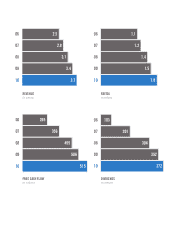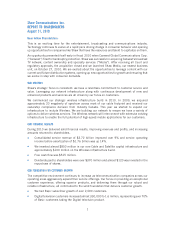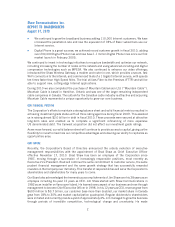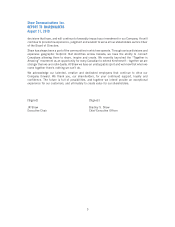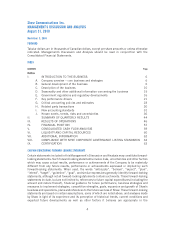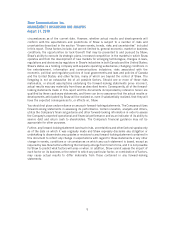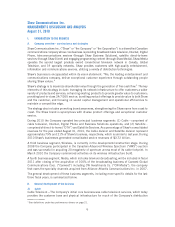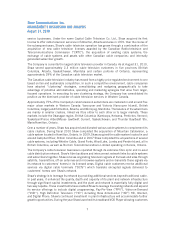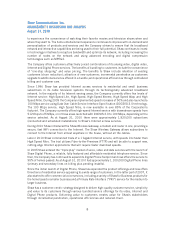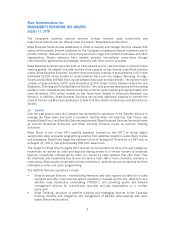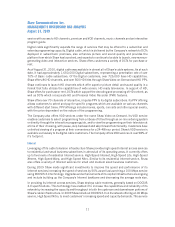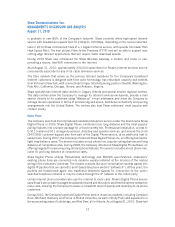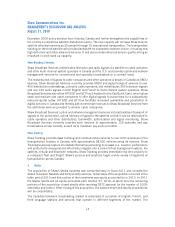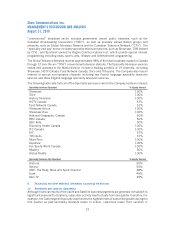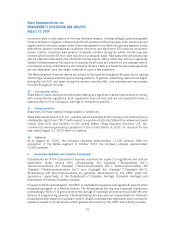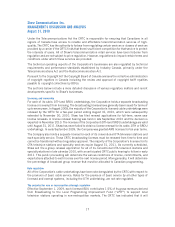Shaw 2010 Annual Report Download - page 11
Download and view the complete annual report
Please find page 11 of the 2010 Shaw annual report below. You can navigate through the pages in the report by either clicking on the pages listed below, or by using the keyword search tool below to find specific information within the annual report.service businesses. Under the name Capital Cable Television Co. Ltd., Shaw acquired its first
license to offer cable television services in Edmonton, Alberta and area in 1970. Over the course of
the subsequent years, Shaw’s cable television operation has grown through a combination of the
acquisition of new cable television licenses awarded by the Canadian Radio-television and
Telecommunications Commission (“CRTC”); the acquisition of existing cable systems; the
exchange of cable systems and assets with other Canadian cable companies; and internally
generated subscriber growth.
The Company is currently the largest cable television provider in Canada. As at August 31, 2010,
Shaw served approximately 2.3 million cable television customers in five provinces (British
Columbia, Alberta, Saskatchewan, Manitoba and certain portions of Ontario), representing
approximately 29% of the Canadian cable television market.
The Canadian cable television industry has moved from a highly price regulated environment to one
based on fair and sustainable competition. In such a competitive environment, cable companies
have adopted “clustering” strategies, consolidating and realigning geographically to take
advantage of potential administrative, operating and marketing synergies that arise from larger,
focused operations. In executing its own clustering strategy, the Company has consolidated its
position as the dominant provider of cable television services in Western Canada.
Approximately 75% of the Company’s cable television subscribers are clustered in and around five
major urban markets in Western Canada: Vancouver and Victoria (Vancouver Island), British
Columbia; Calgary and Edmonton, Alberta; and Winnipeg, Manitoba. The balance of its subscribers
are mainly in smaller clusters, linked via fibre either to each other or to larger markets. These
markets include the Okanagan region, British Columbia (Kamloops, Kelowna, Penticton, Vernon);
Saskatoon/Prince Albert/Moose Jaw/Swift Current, Saskatchewan; and Thunder Bay/Sault Ste.
Marie/Hamilton, Ontario.
Over a number of years, Shaw has acquired and divested various cable systems to complement its
cable clusters. During fiscal 2010 Shaw completed the acquisition of Mountain Cablevision, a
cable system located in Hamilton, Ontario. In 2009, Shaw acquired the cable system located in and
around Campbell River, British Columbia and in 2007 Shaw completed the acquisitions of several
cable systems, including Whistler Cable, Grand Forks, Wood Lake, Lumby and Pender Island, all in
British Columbia, as well as Norcom Telecommunications Limited operating in Kenora, Ontario.
The Company’s cable television business is operated through its extensive fibre optic and co-axial
cable distribution network. Shaw’s fibre backbone and interconnect network links its cable systems
and subscribers together. Shaw receives originating television signals at its head-end sites through
satellite, transmitters, off-air antennae and microwave systems and re-transmits these signals via
its network to customers’ homes in its licensed areas. Digital cable customers receive additional
services via digital cable terminals (“DCTs”) which translate encrypted signals delivered to
customers’ homes over Shaw’s network.
Shaw’s strategy is to leverage its network by providing additional services beyond traditional cable.
In past years, it enhanced the quality, depth and capacity of its plant and network infrastructure
through significant capital investments, and the plant and network is essentially fully digital and
two-way capable. These investments have enabled Shaw to leverage its existing network and expand
its service offerings to include digital programming, Pay-Per-View (“PPV”), Video-on-Demand
(“VOD”), High Definition Television (“HD”) including three dimensional (“3D”) HD, Internet,
and Digital Phone. Shaw’s continued investment in plant infrastructure will accommodate further
growth opportunities. During the year Shaw launched its broadband VOD Player allowing customers
7
Shaw Communications Inc.
MANAGEMENT’S DISCUSSION AND ANALYSIS
August 31, 2010




